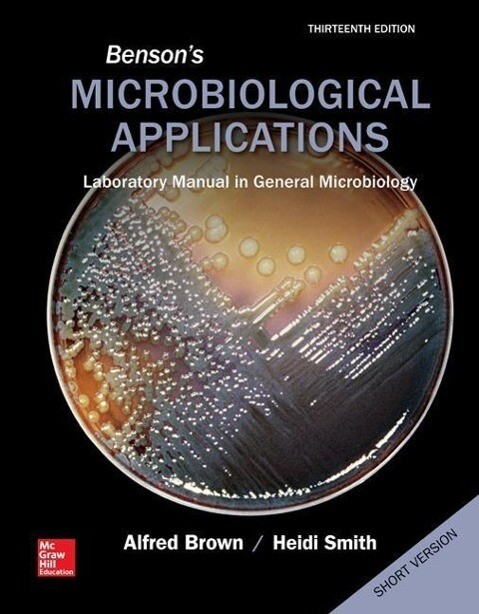
Zustellung: Di, 29.07. - Mo, 04.08.
Versand in 3-4 Wochen
VersandkostenfreiNEW EDITION COMING OCTOBER 2016
Benson's Microbiological Applications has been the gold standard of microbiology lab manuals for over 30 years. The self-contained, clearly-illustrated exercises and four-color format makes this the ideal lab manual. Appropriate for either a majors or non-majors lab course, this manual assumes no prior organic chemistry has been taken. Use McGraw-Hill's Learning Solutions to make this manual fit your exact course needs! Add or remove exercises, include your own material, re-order to fit your course - the possibilities are endless.
Benson's Microbiological Applications has been the gold standard of microbiology lab manuals for over 30 years. The self-contained, clearly-illustrated exercises and four-color format makes this the ideal lab manual. Appropriate for either a majors or non-majors lab course, this manual assumes no prior organic chemistry has been taken. Use McGraw-Hill's Learning Solutions to make this manual fit your exact course needs! Add or remove exercises, include your own material, re-order to fit your course - the possibilities are endless.
Inhaltsverzeichnis
< h2> Part 1 Microscopy< h3> 1 Brightfield Microscopy< h3> 2 Darkfield Microscopy< h3> 3 Phase-Contrast Microscopy< h3> 4 Microscopic Measurements< h2> Part 2 Survey of Microorganisms< h3> 5 Microbiology of Pond Water - Protists, Algae, and Cyanobacteria< h3> 6 Ubiquity of Bacteria< h3> 7 The Fungi: Molds and Yeasts< h2> Part 3 Manipulation of Microorganisms< h3> 8 Aseptic Technique< h3> 9 Pure Culture Techniques< h2> Part 4 Staining and Observations of Microorganisms< h3> 10 Smear Preparation< h3> 11 Simple Staining< h3> 12 Negative Staining< h3> 13 Capsular Staining< h3> 14 Gram Staining< h3> 15 Spore Staining: Two Methods< h3> 16 Acid-Fast Staining: Kinyoun Method< h3> 17 Motility Determination< h2> Part 5 Culture Methods< h3> 18 Culture Media Preparation< h3> 19 Enumeration of Bacteria: The Standard Plate Count< h3> 20 Slide Culture: Fungi< h2> Part 6 Bacterial Viruses< h3> 21 Determination of a Bacteriophage Titer< h3> 22 Isolation of Phage from Flies< h3> 23 Phage Typing< h2> Part 7 Environmental Influences and Control of Microbial Growth< h3> 24 Effects of Oxygen on Growth< h3> 25 Temperature: Effects on Growth< h3> 26 pH and Microbial Growth< h3> 27 Water Activity and Osmotic Pressure< h3> 28 Ultraviolet Light: Lethal Effects< h3> 29 The Effects of Lysozyme on Bacterial Cells< h3> 30 Evaluation of Alcohol: Its Effectiveness as an Antiseptic< h3> 31 Antimicrobic Sensitivity Testing: The Kirby-Bauer Method< h3> 32 Evaluation of Antiseptics: The Filter Paper Disk Method< h3> 33 Effectiveness of Hand Scrubbing< h2> Part 8 Identification of Unknown Bacteria< h3> 34 Morphological Study of An Unknown Bacterium< h3> 35 Cultural Characteristics< h3> 36 Physiological Characteristics: Oxidation and Fermentation Stet Reactions< h3> 37 Physiological Characteristics: Hydrolytic and Degradative Stet Reactions< h3> 38 Physiological Characteristics: Multiple Test Media< h3> 39 Use of Bergey's Manual< h2> Part 9 Miniaturized Multitest Systems< h3> 40 Enterobacteriaceae Identification: The API 20E System< h3> 41 Enterobacteriaceae Identification: The Enterotube II System< h3> 42 O/F Gram-Negative Rods Identification: The Oxi/Ferm Tube II System< h3> 43 Staphylococcus Identification: The API Staph System< h2> Part 10 Applied Microbiology< h3> 44 Bacterial Food Counts< h3> 45 Bacteriological Examination of Water: Most Probable Number Determination< h3> 46 Bacteriological Examination of Water: The Membrane Filter Method< h3> 47 Reductase Test< h3> 48 Temperature: Lethal Effects< h3> 49 Microbial Spoilage of Canned Food< h3> 50 Microbiology of Alcohol Fermentation< h2> Part 11 Medical Microbiology< h3> 51 The Staphylococci: Isolation and Identification< h3> 52 The Streptococci and Enterococci: Isolation and Identification< h3> 53 Gram-Negative Intestinal Pathogens< h3> 54 A Synthetic Epidemic< h2> Part 12 Immunology and Serology< h3> 55 Slide Agglutination Test: Serological Typing< h3> 56 Slide Agglutination Test for S. aureus< h3> 57 Slide Agglutination Test for Streptococcus< h3> 58 The Heterophile Antibody Test< h3> 59 Blood Grouping< h4> Appendices
Produktdetails
Erscheinungsdatum
21. Januar 2014
Sprache
englisch
Auflage
13th Revised edition
Seitenanzahl
480
Autor/Autorin
Alfred Brown, Heidi Smith
Verlag/Hersteller
Produktart
kartoniert
Gewicht
839 g
Größe (L/B/H)
206/272/20 mm
ISBN
9780073402413
Bewertungen
0 Bewertungen
Es wurden noch keine Bewertungen abgegeben. Schreiben Sie die erste Bewertung zu "Benson's Microbiological Applications, Laboratory Manual in General Microbiology, Short Version" und helfen Sie damit anderen bei der Kaufentscheidung.







